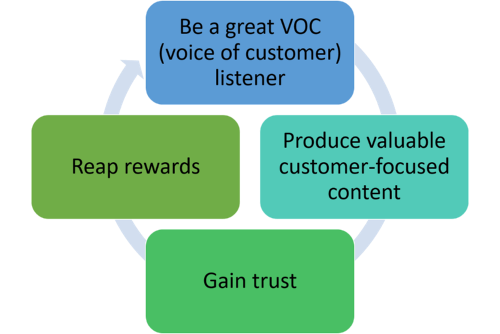The First Step To Creating a Killer B2B Paid Social Strategy
So, we know that most B2B companies really should have a killer Paid Social strategy these days. But as soon as they get on board with the idea, the most frequent question I hear is undoubtedly “What kind of content should we produce for promotion?“ The simple answer is – content that is helpful to your audiences (as opposed to promoting yourself) in the form of blog post, whitepapers, case studies, support videos, etc.
But even that high-level answer can leave me with confused looks. Most marketing executives and/or product managers have a good idea of a few pieces they could produce, but you can tell they have trouble comprehending how to keep their content fresh and valuable as time goes on.
Be social on social media
Ultimately, I believe the answer lies in the social aspect of social media…engagement. The largest percentage of good engagement is listening. There’s a lot of ways you can listen for things that are important to your industry; and it doesn’t have to be online of course. You can and should gain market intelligence in a lot of different ways (focus groups, surveys, etc.). But probably nothing is as cheap and speedy as social media.
There’s a plethora of tools available ranging in price from free to thousands of dollars per month, depending on what your needs are (Buffer, Hootsuite, and Sprout Social supply a nice range of choices). But ultimately, if you’re going to use social media optimally for your business, you’ve got to be a good listener.
2 dimensions of listening
The first dimension of listening is people (duh right?!). Using these valuable tools, you can listen in to the conversations of all types of people that are important to your business. Consider this list…
- Competitors
- Customers
- Channel partners
- Regulatory agencies and commissioners
- Legislators
- Influential authors, journalists and bloggers
- Prominent individuals within all of the above institutions
- Topics relevant to your market
Listening to people should give you a wide breadth of perspective on the issues your industry and customers face.
The second dimension of listening is conversations. Whether it be through groups, discussion boards or Twitter chats, you can pick up a lot of market intelligence by listening to a bunch of people talk about the same issues. You can follow feeds and alerts for relevant groups, keyword searches, hashtags, etc.
Listening on both of these dimensions should give you plenty of ideas for constant, good, fresh content.
Here are some of the things you’re going to hear that should get the creative juices flowing…
- What they say about your company, your competitors or your industry
- Questions they have about your industry, products or services
- Advice on how you can do better (that you may solicit)
- Frustrations and needs they express about your industry and its products
- Changes taking place in your industry
Given this information, there’s a wide range of content options you’ll be inspired to create…
- Answers to questions
- How to solve a problem
- Developments in technology
- New research
- Interesting insights from others
- Customer support pieces
The cycle of social media success
Ultimately, your goal is to build your customers’ trust in doing business with you for the long haul. Listening is the first step in this social media cycle of success…
For B2B companies, the ability to follow this cycle of success determines if social media is either valuable or a resource drain. If you’re investing in social media and you’re not really listening – like REALLY listening – you’re likely just posting company-focused content; which means you’re doing social media all wrong.
Without a killer listening strategy, it’s going to be really hard to develop a killer overall Paid Social strategy. In fact, listening needs to be part of the strategy. It’s really the key to populating your conversations with content that will resonate with your audience and build trust over time to keep the long-term relationships that are so important for B2B companies.



